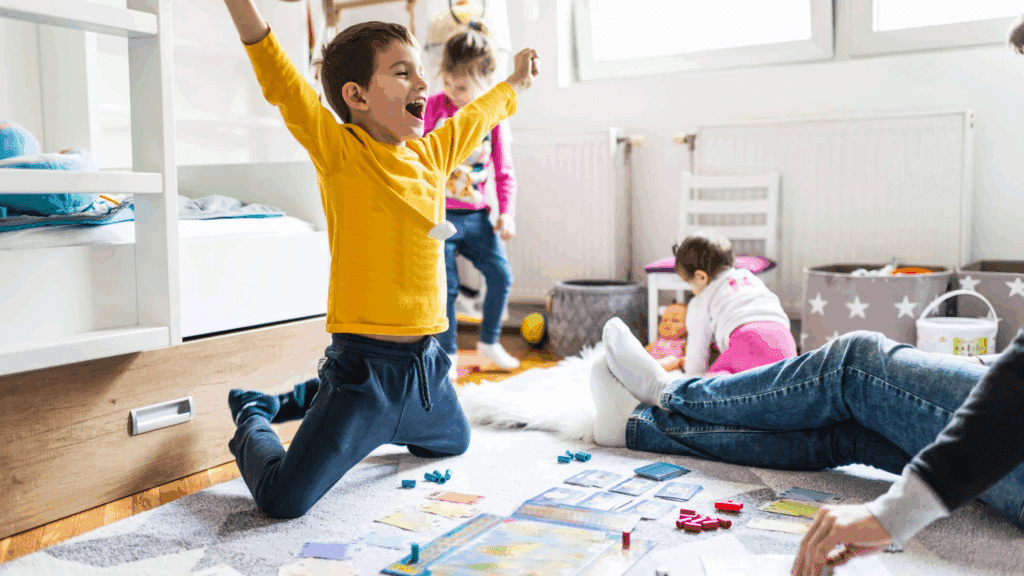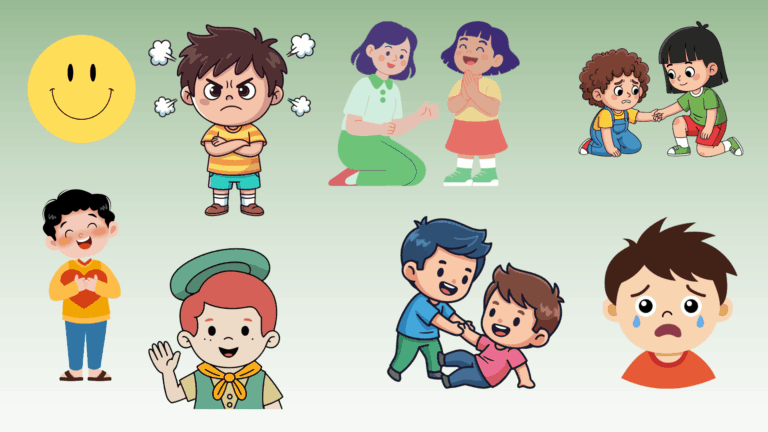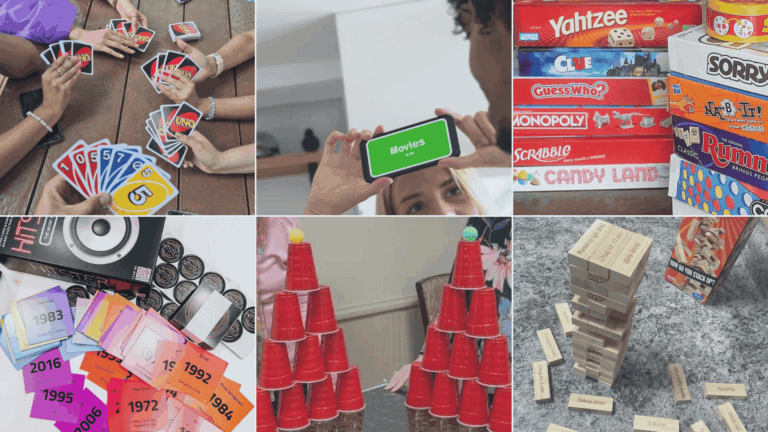Parents often struggle to find the right activities to keep their 5-year-olds engaged and learning.
With endless energy and growing curiosity, children at this age need more than just free play to develop essential skills. The good news is that practical activities don’t require expensive toys or complicated setups.
This blog provides simple, practical activities that support brain development and keep children entertained.
Parents will find easy-to-follow ideas using everyday household items. Each activity focuses on building essential skills like problem-solving, creativity, and social interaction while maintaining the fun factor that 5-year-olds crave.
When to Start Planning Activities for 5-Year-Olds
Planning activities for 5-year-olds isn’t something you need to stress about months in advance, but a little forethought goes a long way in keeping everyone happy and engaged.
Here’s when and how to plan effectively:
- Big activities (playdates, trips, parties): plan about a week ahead to build excitement without constant “Is it time yet?” questions
- Daily activities: keep it loose and spontaneous, but have a general structure in mind
- Morning activities: plan high-energy adventures when kids are fresh and energetic
- Afternoon activities: schedule quieter crafts or reading time after lunch when energy dips
- Weather-dependent plans: check forecasts a few days out to pivot from outdoor to indoor alternatives
- Backup activities: always have a Plan B ready because 5-year-olds are unpredictable
- Seasonal activities: plan 2-3 weeks ahead for holiday crafts or seasonal outings
- Supply-heavy projects: give yourself a few days to gather materials without last-minute store runs
Brilliant Activities For 5 Year Olds
Finding fun activities for 5-year-olds is easy! At this age, kids learn best through play and hands-on experiences.
These simple, engaging ideas build motor skills, spark creativity, and encourage social interaction, using everyday items you likely already have at home.
Indoor Activities
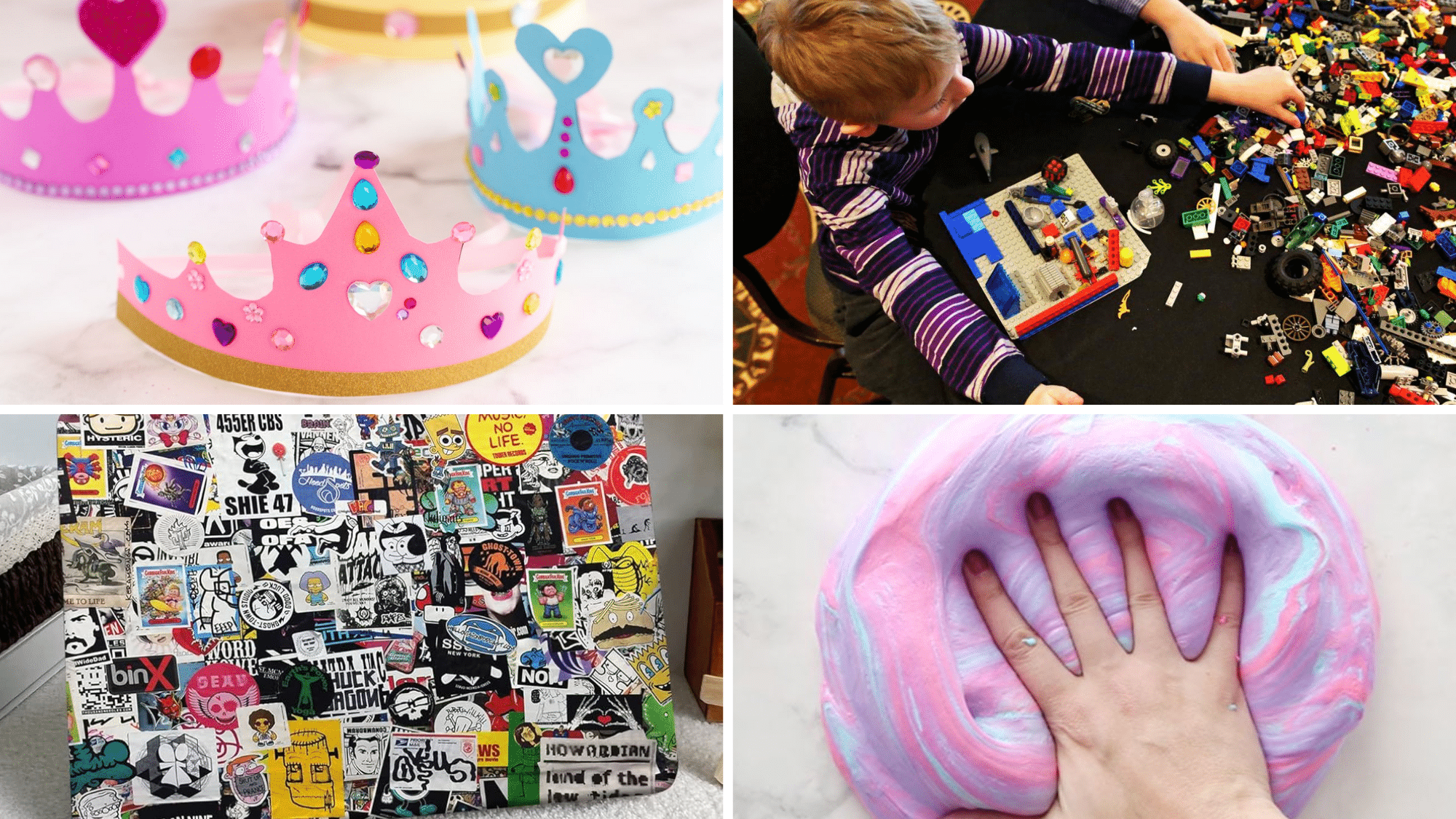
Indoor activities are perfect for rainy days, quiet afternoons, or focused playtime at home. These activities help children find out creativity, build fine motor skills, and enjoy imaginative play in a safe, familiar space.
Best of all, most require only simple materials you already have at home.
1. Paper Plate Masks – The child can use paper plates, string, and markers to create funny or animal masks. It boosts creativity and fine motor skills. They can put on a show for family or friends after crafting.
2. Sock Puppet Show – Using old socks, buttons, and glue, they can make puppets and create their own mini-theater. This activity supports storytelling, communication, and dramatic expression.
3. Lego Building Time – Give them a mix of blocks and a fun prompt like building a zoo or space station. Encourages creative thinking and spatial skills while they play.
4. Sticker Collage – Offer a variety of stickers and a sheet of paper to design a collage. It’s calming, helps with fine motor control, and builds visual expression.
5. Storybook Reading Fort – Build a blanket fort using chairs and sheets and bring a few favorite books inside. This creates a cozy space that encourages quiet time and love for reading.
6. Indoor Obstacle Course – Use soft furniture, cushions, and toys to create an obstacle path. It promotes active movement, coordination, and balance indoors.
7. DIY Slime Making – Mix school glue, baking soda, and contact lens solution to make slime. Kids enjoy the texture and can customize it with colors or glitter.
8. Cooking with a Grown-Up – Let them help stir, pour, or decorate food like cupcakes or pancakes. Teaches math, patience, and independence in a fun environment.
9. Puzzle Time – Choose puzzles with 24 to 48 pieces for age-appropriate fun. Solving puzzles improves focus, memory, and visual problem-solving skills.
10. Paint with Watercolors – Set out brushes and watercolor paints on thick paper. This lets kids experiment with colors while minimizing mess.
11. Recycled Craft Building – Collect household materials like cartons and bottle caps. Kids can build robots, cars, or animals, which boosts their creative thinking and problem-solving skills.
12. Indoor Scavenger Hunt – Create a list of everyday objects and hide them around the house. Helps improve attention, memory, and excitement.
13. Play-Dough Bakery – Use play-dough to pretend-bake cakes, cookies, or pizzas. It strengthens fingers and sparks imaginative play.
14. Matching Card Games – Use memory cards or regular decks to play match games. Boosts concentration, short-term memory, and turn-taking.
15. Rainbow Rice Sensory Bin – Dye rice with food coloring and place in a tub with scoops. It’s relaxing and gives hours of hands-on fun.
16. Musical Freeze Game – Dance to music, then freeze when it stops! This helps with listening, self-regulation, and energy release.
17. Sorting by Colors or Shapes – Give them objects to sort by category. This early math activity sharpens observation and thinking skills.
18. Dance Party with Scarves – Turn on music and give scarves to twirl while dancing. It’s expressive, fun, and improves coordination.
19. Marble Run on the Wall – Tape cardboard tubes to a wall and roll marbles through. Great for STEM thinking and testing ideas.
20. Balloon Tennis – Use paper plate paddles and a balloon for safe, indoor tennis. Builds reflexes and balance in a playful way.
21. Dress-Up Parade – Pull out costumes or clothes and let them put on a fashion show. It boosts imagination, confidence, and storytelling.
22. Shadow Puppet Show – Use a flashlight and paper cutouts to create shadows on the wall. Encourages narrative play and science curiosity.
23. Color by Numbers – Use color-by-number sheets to improve number and color skills. It also helps maintain focus on a task.
24. DIY Music Instruments – Make maracas with jars of rice or rubber band guitars. Combines creativity with music exploration.
25. Match the Socks Game – Toss clean socks in a pile and have them find pairs. A simple sorting game that builds logic and neatness.
26. Threading Beads onto Strings – Use plastic beads and string to make bracelets or patterns. This improves precision and fine motor control.
27. Counting Games with Toys – Ask them to count how many blocks, cars, or plush toys they have. Helps with math readiness and sorting.
28. Yoga for Kids – Try videos for young children to practice yoga stretches. It boosts flexibility, focus, and calm behavior.
29. Window Painting with Chalk Markers – Let them draw on windows with washable chalk markers. Adds creativity and is easy to clean.
30. Color Sorting Ice Cube Trays – Give small objects to sort into trays by color. Encourages organization and categorization.
31. DIY Crown Making – Cut paper or cardboard into crown shapes and decorate with stickers. Builds pride, patience, and style.
32. Measuring Ingredients for Play Recipes – Pretend to cook using cups, spoons, and dry ingredients. Teaches measuring and cooperation.
33. Audio Story Time – Play audiobooks or story podcasts during quiet time. Great for comprehension and imagination without screen use.
Outdoor Activities
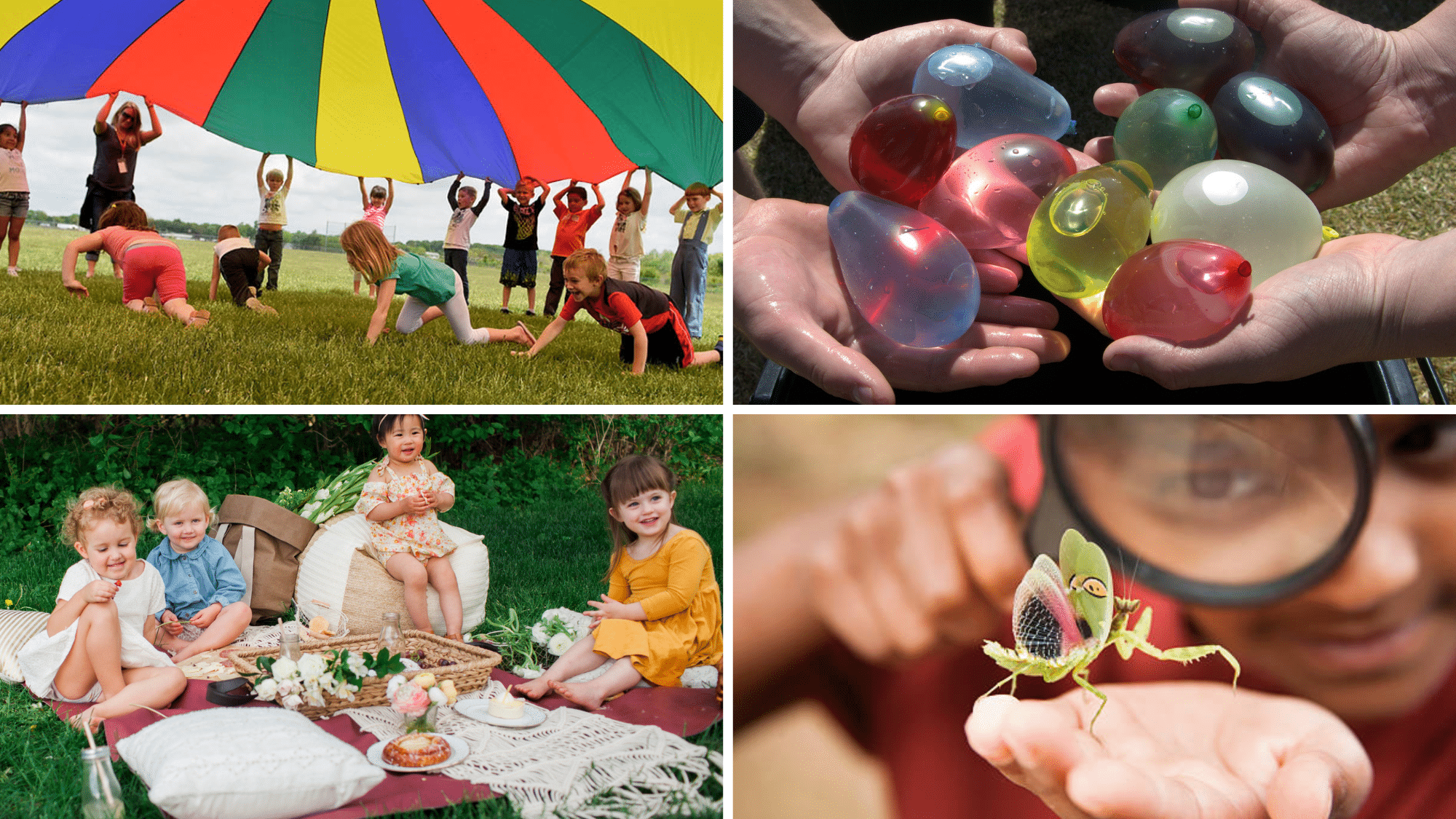
Outdoor play is key to healthy growth, building strength, coordination, and social skills. Simple activities like nature walks, chalk art, races, and kite flying get kids moving and exploring.
Even a small yard or local park can become a fun space for adventure and family bonding.
34. Sidewalk Chalk Art – Give kids colorful chalk to draw shapes, letters, or pictures on the sidewalk. It builds fine motor control and creative confidence outdoors.
35. Nature Treasure Hunt – Create a checklist of items like a feather, leaf, or rock. Kids can search around the yard or park while learning to observe closely.
36. Bubble Blowing Race – Use wands or blowers to create and chase bubbles. They’ll improve hand control, run around, and laugh a lot in the fresh air.
37. Water Balloon Toss – Fill small balloons and toss them gently to a partner. Encourages coordination, timing, and social interaction through water play.
38. Tricycle Ride Around the Block – Supervise them riding around a safe path. It builds leg strength, balance, and traffic awareness through active fun.
39. Build a Fairy Garden – Use soil, pebbles, plants, and tiny figures to make a magical garden corner. Great for creative play and sensory exploration.
40. Leaf Rubbing Art – Place a leaf under a paper and rub crayons over it to reveal patterns. Helps kids learn texture and structure from nature.
41. Mini Car Wash – Give soapy water and sponges to wash toy cars. A fun mix of pretend play and responsibility, especially on sunny days.
42. Bug Catch and Release – Catch small bugs in cups and observe them before releasing. Encourages curiosity, respect for life, and science learning.
43. Jump Rope Games – Teach simple jump rope songs or rhythms. It helps develop timing, balance, and endurance through repetition.
44. Hopscotch with Numbers – Draw hopscotch on the pavement and jump through numbers. This classic game boosts balance and early math awareness.
45. Backyard Picnic – Lie on a blanket and eat lunch or snacks outdoors. Encourages calm, screen-free meals and appreciation for nature.
46. Build with Sticks and Stones – Collect materials and build towers or shapes. It combines engineering thinking with natural textures and patience.
47. Mud Kitchen Pretend Play – Use soil, water, and old kitchenware to mix pretend meals. Stimulates imagination and messy outdoor fun.
48. Watering the Garden – Give them a watering can and let them help plants grow. Teaches care, routine, and connection to the environment.
49. Frisbee Toss – Toss a light frisbee back and forth in the park. Develops aim, strength, and cooperative play while moving around.
50. Obstacle Course with Cones – Set up cones, ropes, or tunnels to run through. Builds strength, focus, and resilience through movement.
51. Catching Falling Leaves – Try to catch leaves midair during fall. Encourages attention, reflexes, and playful interaction with seasons.
52. Nature Drawing Session – Take art outside and draw real flowers, clouds, or bugs. Inspires mindfulness and connects art with nature.
53. Follow the Leader in the Yard – Copy each other’s walks, hops, and turns. Strengthens listening skills, movement, and leadership.
54. Rock Painting – Paint happy faces or patterns on smooth rocks. This item combines creativity with nature and can be used to decorate paths.
55. Bug Hotel Making – Stack twigs and bark in a box to attract bugs. Supports understanding of mini habitats and builds eco-awareness.
56. Sandpit Digs – Hide toys in a sandbox and let kids dig and find them. Encourages exploration, muscle use, and patience.
57. Planting a Seed – Let them dig a hole, plant seeds, and water them. Offers lessons in growth, care, and observing nature’s evolution over time.
58. Tree Bark Rubbings – Rub crayons on paper placed over tree bark. Reveals textures and introduces patterns in the natural world.
59. Relay Races – Set up simple sprints with tasks like spoon balancing. Kids love the energy and develop team spirit and balance.
60. Parachute Play – Use a big sheet and lift it in the air together. Kids run underneath, learning timing, joy, and cooperation.
61. Chalk Maze on Pavement – Draw paths or mazes for toys or feet to follow. It builds planning, decision-making, and imagination.
62. Build a Bird Feeder – Use pinecones, peanut butter, and seeds to feed birds. Nurtures responsibility, creativity, and nature care.
63. Giant Tic Tac Toe with Cones – Create a grid and toss bean bags to play. Teaches turn-taking, logic, and active outdoor focus.
64. Splash in Rain Puddles – Put on boots and let them jump in puddles. A simple, joyful activity that releases energy in all weather.
65. Balloon Stomp Game – Tie balloons to ankles and try stomping others’. It’s silly and social, encouraging movement and awareness.
66. Ball Rolling Down Ramps – Create ramps from cardboard and race balls down. Teaches cause-and-effect and introduces basic physics.
67. Find Shapes in the Clouds – Lie back on the grass and spot shapes in the sky. Encourages creativity, calm, and connection to nature.
68. Collect Fallen Petals or Leaves – Pick up colorful petals or leaves and save them. Great for crafting or making simple nature art.
69. Giant Bubbles with Hoops – Use large wands or hoops to blow oversized bubbles. Kids chase and pop them with joy and movement.
70. Climb a Low Tree or Play Structure – With supervision, let them climb safely. Builds physical strength, problem-solving, and courage.
71. Bean Bag Toss into Buckets – Set up bins and toss bean bags into them. Improves aim, coordination, and fine motor skills.
72. Nature Bracelet with Tape – Wrap tape sticky side out on wrists and stick petals on, a wearable craft using natural items.
73. Run Through a Sprinkler – On warm days, let them run through sprinklers. Great for full-body activity and hot weather joy.
74. Walk the Dog Together – Let the child help walk or command the dog. Builds a connection with pets and gentle responsibility.
75. Wind Chime Listening Game – Sit quietly outdoors and listen for chimes or birds: Fosters mindfulness and sensory awareness.
76. Hula Hoop Challenges – Roll or spin hula hoops in fun contests. Boosts rhythm, flexibility, and confidence through movement.
77. Hide and Seek Behind Trees – Classic hide and seek using natural cover. Encourages playful thinking and physical activity.
78. Follow Animal Tracks in the Dirt – Look at paw prints or bug trails and guess who made them. This sparks observation and wonder.
79. Find out a New Trail or Park – Take a walk somewhere new and point out sights. Builds curiosity, fitness, and confidence.
80. Shell Collecting at the Beach – Search for shells and sort by size or color. Combines science and play at the water’s edge.
81. Make Footprints in the Sand – Step in wet sand and observe the prints. Fun to compare sizes and watch them disappear.
82. Fly a Kite on a Windy Day – Let them run with a kite and watch it soar. Builds patience, motor control, and outdoor love.
Screen-Free Activities
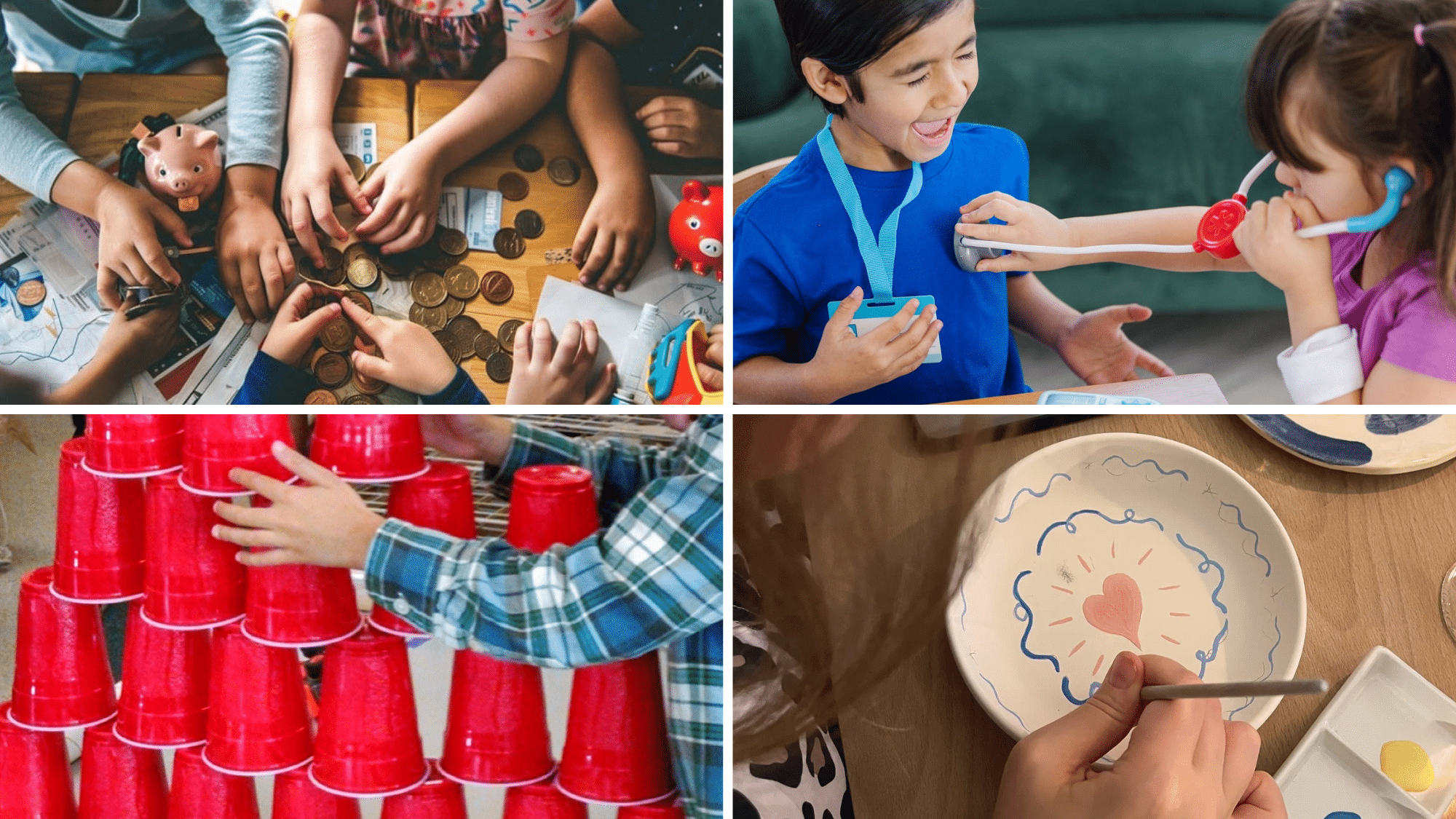
In a screen-filled world, screen-free activities help kids reconnect, imagine, and explore. These hands-on ideas spark creativity, problem-solving, and real-world play.
From building to crafting, each activity fuels curiosity, no screens needed, just pure fun and learning.
83. Pretend Store Play – Set up a mini shop using play money, baskets, and household items. Kids can take turns being the shopkeeper or customer. This fosters imagination, social skills, and early math thinking.
84. Build a Blanket Tent – Use chairs, cushions, and blankets to create a cozy hideout. Kids can read, nap, or pretend inside. It encourages creativity and offers a quiet personal space.
85. Animal Charades – Pick an animal and act it out without making sounds. Others guess what it is. Builds movement skills, imagination, and the ability to communicate nonverbally.
86. Sorting Coins or Buttons – Give a pile of buttons or coins to sort by color, size, or shape. This introduces classification and math skills in a hands-on and relaxing way.
87. Role Play Doctor or Vet – Use a toy stethoscope and stuffed animals to treat pretend patients. Helps children express empathy and understand real-world roles through dramatic play.
88. Making Greeting Cards – Fold paper and decorate cards for friends or family. Add stickers, drawings, or sweet notes. Encourages kindness, self-expression, and writing practice.
89. Match the Socks Game – Dump out a pile of mixed socks and let them find all the pairs. It’s simple, satisfying, and builds sorting, logic, and concentration.
90. Pretend School Time – Set up a toy classroom and let the child be the teacher. Use books, chalkboards, and dolls. Promotes leadership, organization, and literacy.
91. Finger Painting on Paper Plates – Let them dip their fingers into paint and design on plates. It’s colorful, tactile, and perfect for creative expression and sensory input.
92. Sorting Toys by Color – Ask them to group cars, blocks, or animals by color. This builds organization, observation, and early pattern recognition skills.
93. Mystery Bag Game – Fill a bag with random household items. Have them reach in and guess what each is by touch. Great for sensory development and critical thinking.
94. Make a Family Tree with Photos – Use printed photos or drawings to make a visual tree. Connect names and relationships. Helps them understand family structure and memory.
95. Create a Story with Pictures – Draw or cut out images to sequence a story. Kids can narrate what’s happening. This builds storytelling skills and sequencing awareness.
96. Stack the Plastic Cups – Give them lightweight cups to build tall towers or pyramids, a fun way to Find out balance, stability, and construction play.
97. Clay Sculpting Time – Use soft modeling clay to create animals, fruits, or shapes. Supports fine motor skills, patience, and hands-on creativity.
98. Count and Stack Blocks – Ask them to build towers and count the blocks as they go. Combines physical play with math and measurement skills.
99. Make Paper Airplanes – Teach them how to fold paper planes and fly them across a room. Inspires focus, experimentation, and friendly competition.
100. Create a Chore Chart Together – Design a simple chart for daily tasks with checkmarks or stickers. Teaches structure, responsibility, and pride in helping.
101. Simon Says Game – Give a series of commands starting with “Simon says.” Builds listening skills, body awareness, and understanding of instructions playfully.
102. Create a Postcard for Someone Far Away – Let them draw and write on a homemade postcard. Pretend to mail it. Encourages thoughtfulness and creative writing.
103. Make a Collage from Old Magazines – Cut and glue colorful images into a themed collage. Great for artistic expression, scissor practice, and visual storytelling.
104. DIY Puppet Theater with a Box – Cut windows into a box and put on a puppet show. Use socks, paper puppets, or toys. It fosters storytelling and stage confidence.
105. Create a Weekly Weather Chart – Use icons for sun, rain, clouds, and track each day’s weather. Supports routine, scientific curiosity, and observation skills.
106. ABC Treasure Hunt Around the House – Find objects that start with each letter of the alphabet. For example, using an apple for A or a book for B helps build phonics and exploration.
107. Make Friendship Bracelets – Use yarn or beads to braid bracelets for friends or siblings. Enhances fine motor skills, patience, and kindness through crafting.
108. Dance with Ribbons – Give them ribbon wands or scarves to twirl while dancing. Boosts rhythm, spatial awareness, and expressive movement.
109. Practice Wrapping Gifts – Use empty boxes, old wrapping paper, and ribbon. Kids practice folding and taping. A fun life skill activity for birthdays or holidays.
110. Thread Pasta Necklaces – Dye pasta different colors and let them string it on yarn. Develops coordination and results in wearable art.
111. Create a Shape Sorting Board – Draw shapes on a board and match cutouts to them. Builds visual recognition, matching, and geometric thinking.
112. Make Your Own Board Game – Let them draw paths and rules for a simple board game. It strengthens rule-following, design, and turn-taking.
113. “Guess the Sound” Game – Make different household sounds behind a curtain and let them guess. Enhances auditory processing and memory.
114. Indoor Bowling with Plastic Bottles – Line up plastic bottles and roll a soft ball to knock them down. Fun, safe, and teaches aim and counting.
115. Fold Laundry Together – Let them match socks and fold small towels. Builds responsibility, order, and real-world helping habits.
116. Create a Weather Wheel by drawing a circle divided into weather types and attaching a spinner. Encourages daily tracking and weather learning.
117. Build a Shape Town with Blocks – Use triangle, square, and rectangle blocks to build a town. A fun intro to architecture and planning.
118. Paint with Cotton Swabs – Dip cotton swabs in paint and make dot or line art. Easy to manage and excellent for precision and creativity.
119. Make Up a Silly Song – Create a song using your child’s name, pet’s name, or favorite things. Enhances memory, rhythm, and joy in music.
120. Freeze Dance with No Screens – Use a basic speaker or radio for music. Dance when music plays and freeze when it stops. Simple, fun, and energizing.
121. Make a Calm Down Bottle – Fill a bottle with water, glitter, and glue. Shake it and watch it swirl. A peaceful way to relax and self-soothe.
Why These Activities Boost Brainpower
A 5-year-old’s brain grows faster than at any other time in life. Structured activities help build important connections between brain cells.
- Memory building: Repetitive activities strengthen recall abilities.
- Problem-solving: Puzzles and games teach logical thinking.
- Focus improvement: Structured play increases attention span.
- Language growth: Interactive activities expand vocabulary.
- Motor skills: these include hand movements, are connected to brain development.
- Social skills: Group activities build emotional intelligence.
- Creativity boost: Art and music stimulate the imagination centers.
Conclusion
Planning activities for five-year-olds doesn’t need to be overwhelming. Parents now have simple, practical ideas to support their child’s growth and development.
These activities help build essential skills while keeping children engaged and happy. The key is to start when the child shows readiness and keep things fun rather than forced.
Every small step matters in a child’s development. When parents invest time in structured play, they’re building their child’s confidence, creativity, and learning abilities.
The activities shared here use everyday materials and fit into busy family schedules.
Parents should start with one or two activities that match their child’s interests. Success comes from consistency, not perfection.


